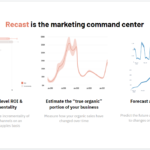What channels drove our revenue last week? What happens if we 2x our spend on Meta? What happens if we pull all our budget on brand search? When will we hit diminishing returns on paid search? What should we project for next quarter? Where should our budget for next year go?
Marketing Mix Modeling should not just be numbers on your screen – it should help you answer key questions and solve real-life marketing problems.
Modern marketers see MMM as a key part of their toolkit, a guiding light in their decision-making process. But we have also seen how MMM can be lost in the theory of itself, and we need to bring back emphasis on its practical implications – this is what we will cover here.
3 Ways Consumer Brands Use Marketing Mix Modeling:
Budget allocation:
The less visibility marketers get from digital tracking, the more they’re looking for different measurement methods that can help guide where their marketing budget is driving the most impact.
In fact, digital tracking / multi-touch attribution was never meant to answer the incrementality question. It’s great for granular, campaign-level decisions (is creative A better than creative B?), but not for high-level budget allocation.
That’s where MMM thrives – to help you understand the drivers of your KPIs by simulating their impact on sales through your model so you can make more informed budget decisions.
You can use the model to audit which channels are driving the most conversions, and how many sales you’d get if you stopped advertising entirely. This information can help you to decide which channels to invest in and which channels your budget is being spent inefficiently.
Forecasting and planning:
A well-designed MMM should include estimates of the causal relationship between the model’s variables and the KPI (often revenue) that you’re tracking it against. If you find true causality, the model can be used to make forward-looking forecasts about what will happen if you change any of the variables (like budget) in the future.
While I know this sounds like having a magic crystal ball, it’s a relatively straightforward process to take a planned budget from a marketer with their expected spend on each channel into the future and apply the MMM estimates to get a forecast.
With Recast, for example, our clients get an interactive tool that marketers can upload budgets to explore the different scenarios and see the forecasts’ results. They can then share that with their stakeholders and align on budgets, KPIs, etc.
Optimization opportunities:
If you can identify the drivers of your KPIs, you can find the areas where you’re overspending or underspending, and make the necessary adjustments to leverage your budget as efficiently as possible.
For example, let’s say you find a channel with a high incremental ROMI (Return On Marketing Investment). How much more should you spend on that channel? 10% more? 50% more? 10x as much?
This will depend on how quickly the channel’s incrementality decreases as you add more spend. We know that, at some point, you will see diminishing returns. Your model should be able to estimate the diminishing return points for each channel so you can be at the optimized sweet spots.
Making Decisions Off Your Marketing Mix Modeling:
The most practical version of MMM is turning your model into a simulator that gives marketers the power to adjust inputs and get forecasts. You also shouldn’t need a team of data scientists to run it – though it’s great if you have one.
A simulator should help you explore different scenarios and make more informed decisions about your marketing strategy and budget allocation decisions.
Recast is doing this for top consumer brands, and we’ve found there are three things you have to get right for your simulator to work:
- User experience:
If you need a development or data team to manage it, you’re limiting its impact. Non-technical users should be able to have a user-friendly interface with intuitive navigation and clear instructions on how to run simulations and make decisions based on them.
- Data integration:
Your simulator needs to integrate seamlessly with all your existing data sources: your marketing automation platform, your CRM, your data warehouse, etc. We’ve seen that clean and automated data is one of MMM’s biggest hurdles and it can really slow down projects. And, of course, if your data isn’t up to date, your results just won’t be accurate.
- Types of simulations:
Your MMM simulation should adjust to your specific needs: if your company operates in a fast-paced industry, you might need real-time simulations based on marketing trends. If, however, you operate in a more stable industry, you might want more flexibility in long-term inputs. Your MMM simulation should adjust to your specific needs.
Traditional MMM would only be done at most quarterly, and sometimes only annually, because of the great cost incurred, and expertise required to build a model. This is too slow for the pace of modern marketing, where you can’t afford to wait until the end of the annual planning cycle to make budget optimization decisions. We recommend weekly updates so you are always up-to-date.
- Complexity of your model:
If your marketing mix only has a few channels that rarely change, your model might be more simple and straightforward – with relatively easy-to-set-up processes to maintain, monitor, and refresh it. However, if your model is complex and involves multiple variables, with new channels coming and going as they are tested and either scaled or discarded, it may be necessary to work with a data scientist or software vendor to make sure your model is properly maintained.
- Build confidence in your model:
Your model should help you make more informed decisions to risky questions – whether it’s because they’re politically sensitive or financially meaningful. While a good model will give you intervals of confidence, it’s essential that you build confidence in it, and a great way to do this is through incrementality tests (lift tests, geo-market tests, etc.).



